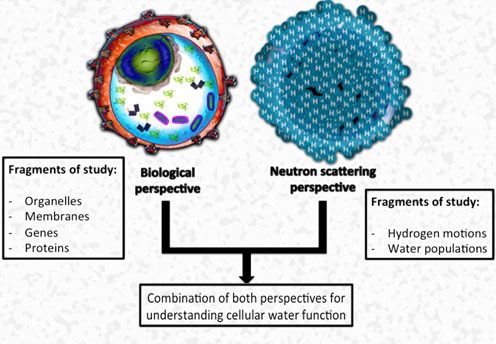New methods from material sciences in physics find their way into cancer research
A new study on the behavior of water in cancer cells shows how methods usually limited to physics can be of great use in cancer research. The researchers, Murillo Longo Martins and Heloisa N. Bordallo at the Niels Bohr Institute, University of Copenhagen, have shown how advanced methods in materials analysis - a combination of neutron scattering and thermal analysis - can be used to map the properties of water in breast cancer cells.

This pilot work shows how the mobility of water molecules confined in cancer cells changes when subjected to treatment with a chemotherapy drug.
This proposed methodology holds potential for advance diseases diagnosis and might guide to the advancement of the approach used in cancer treatment, one of the biggest challenges in medical research.
The result, now published in Scientific Reports, is exactly that.
Comparing cancer cells before and after treatment
When treating cancer with chemotherapy, the drug is usually inserted into the body via the bloodstream. Afterwards the medicament spreads to the entire system, making its way to the cancer cells.
The effect of the drug depends on many, many factors. For example, the properties of intra cellular water are altered by the action of the drug. However the role of water in the development or remission of tumors is likely bigger than so far considered.
This new perspective will be very instrumental in mapping the precise development, when comparing analysis before and after treatment.
Understanding water and its properties – a common denominator for all cancer cells – is vital
Water being the main component in the composition of the cell, understanding its properties, when undergoing treatment for cancer, is vital.
Cancer cells respond differently to different kinds of treatment, so a new unorthodox analysis, using techniques from materials-sciences, of the cell’s main component, its composition and behavior, could be a common denominator in developing new treatments for individual patients.
Murillo Longo Martins, who has been working in this field during his PhD and postdoc at the Niels Bohr Institute, explains: “Our findings indicate that, in the future, drugs can be developed focusing on modifying the properties of cellular water to achieve specific outcomes.
In a shorter term, understanding the dynamics of cellular water may provide complementary knowledge about, for example, why some types of cancers respond differently to certain treatments than others”.
Unorthodoxy as a method
While physicians and biologists perceive cells as an ensemble of membranes, organelles, genes and other biological components, by combining sophisticated neutron scattering techniques and thermal analysis physicists are able to characterize water dynamics in the cell very precisely.
Building a communication interface between these two distinct visions is now proven to be very interesting by the researchers at the Niels Bohr Institute. Their new results can open new areas of inquiry, because of the unorthodox approach.
This result is expected to stimulate future collaborations between distinct scientific communities, and further incentivize the use of materials-science approaches when investigating biological matter.
See also:
Contact
Heloisa Nunes Bordallo, Associate Professor
Xray and Neutron Science
Email: bordallo@nbi.ku.dk
Mobile: +45 21 30 88 29
Murillo Longo Martins, Postdoc Fellow
SNS (Spallation Neutron Source) USA
Email: cpl902@alumni.ku.dk
Jose EM Pereira, Postdoc fellow at IPEN in Brazil
